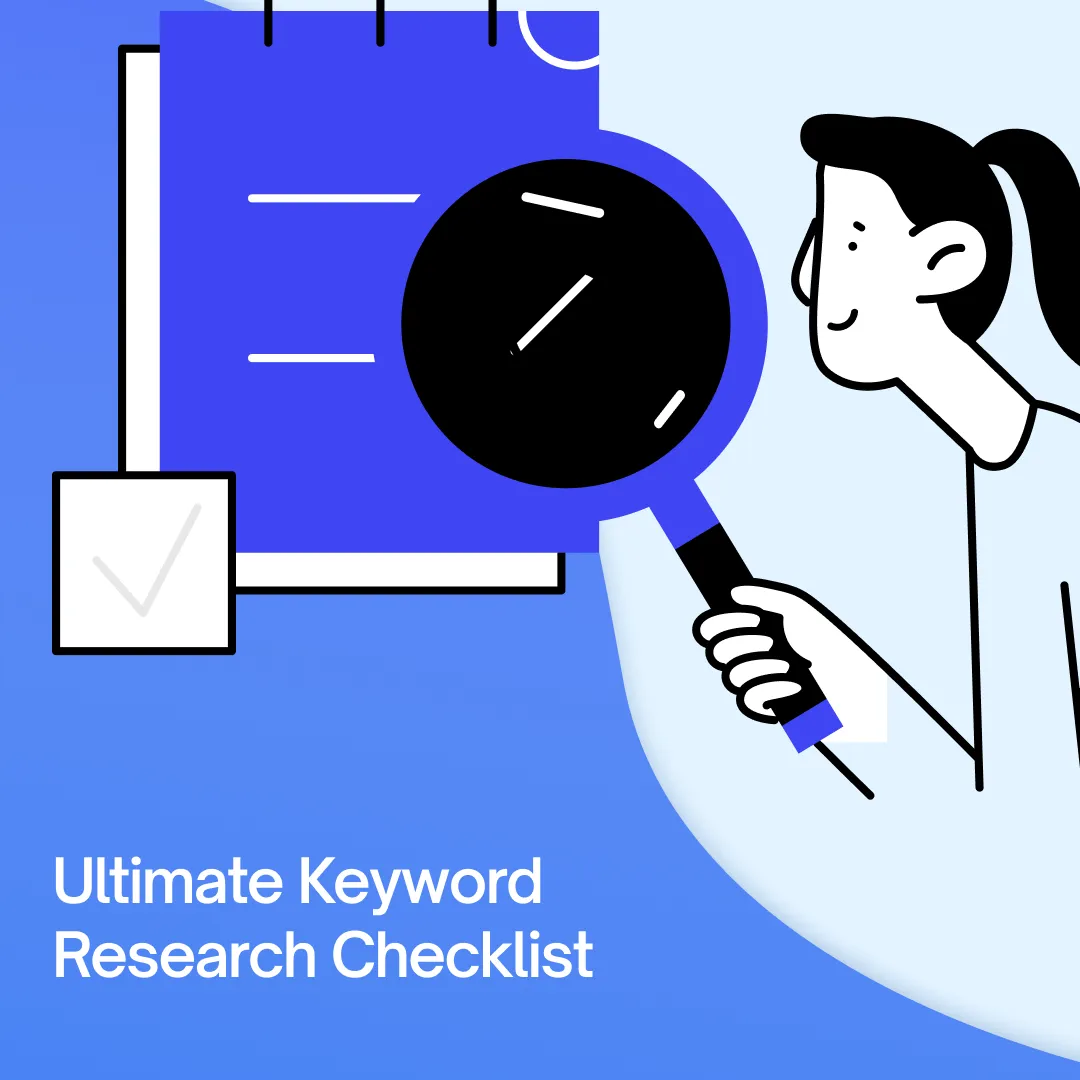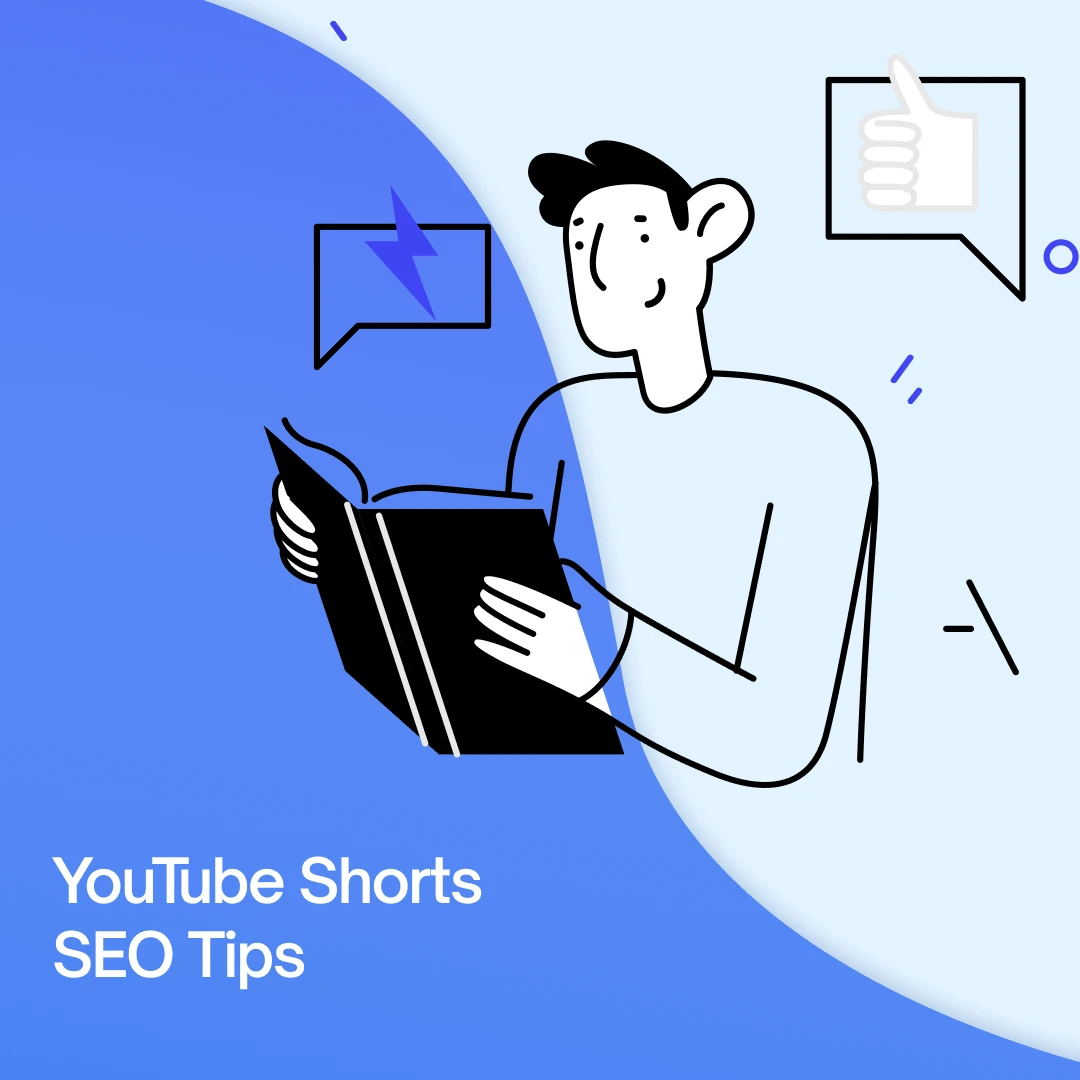YouTube is a great channel for branding and driving conversions. The problem is, it only works if you’re found.
That’s why YouTube SEO matters.
And in this article, we’ll discuss the best practices to get your content seen on YouTube.
Pro tip: Want to get the best results from your YouTube SEO efforts? Bluethings can help you get the most from your YouTube channels.
TL;DR
YouTube SEO helps your videos rank higher on both YouTube and Google, increasing visibility, engagement, and conversions.
Treat YouTube like a search engine by optimizing titles, descriptions, transcripts, tags, and thumbnails.
Focus on audience retention, watch time, and satisfaction—these signals drive algorithmic visibility.
Align content with search intent to reduce drop-offs and increase relevance.
Apply traditional SEO fundamentals such as keyword optimization, metadata, and internal linking.
Track ROI through leads, conversions, and analytics, not just views.
Top 10 YouTube SEO Tips
- Use intent-driven keyword research for long-tail, high-value phrases.
- Write keyword-rich titles and compelling descriptions to improve CTR.
- Design clean, high-contrast thumbnails and A/B test for best performance.
- Add transcripts and captions for accessibility and extra keyword coverage.
- Use timestamps and chapters to boost navigation and search visibility.
- Add cards and end screens to keep viewers in your content ecosystem.
- Improve engagement signals—focus on hooks, pacing, and interactivity.
- Cross-promote videos across blogs, social media, and email newsletters.
- Use analytics for data-driven optimization and scalable growth.
- Integrate AI for ideation, transcripts, and testing while maintaining human oversight.
Bonus Takeaways
- Embed videos with schema markup to improve web SEO.
- Repurpose YouTube content into shorts, posts, or blogs for multi-channel impact.
- Measure success through conversions, brand lift, and audience growth.
- A data-driven, intent-focused strategy turns YouTube from a visibility tool into a revenue engine.
What Is YouTube SEO?
YouTube SEO is the set of practices you apply to your video content so that both search engines (YouTube’s internal search, plus Google Search) and users can discover, understand, and engage with your videos.
For that, you’ll be:
- Optimizing your video title, video description, tags, transcripts, and thumbnails
- Cross-linking between your own videos or playlists
That way, your content surfaces in search results, suggested videos, and embedded placements.
Of course, optimizing your YouTube videos also means keeping viewers engaged.
According to recent SEO stats, YouTube videos with high audience retention and watch time are more likely to rank well in search and suggested feeds. In fact, the top 10% most popular YouTube videos get 79% of the views!

If you want to make it to the top ten, then you’ll need a good YouTube SEO strategy.
That brings us to the next point:
Why Do You Need YouTube SEO?
You might look at YouTube as being just for casual viewing, but you’d be mistaken.
YouTube is now a serious channel for lead generation, branding, and conversion-driven content. That’s why more marketers now consider YouTube as a critical part of any marketing strategy.
It’s no wonder. The YouTube demographic spread means you can reach virtually any target audience you want, whether by location, age, race:
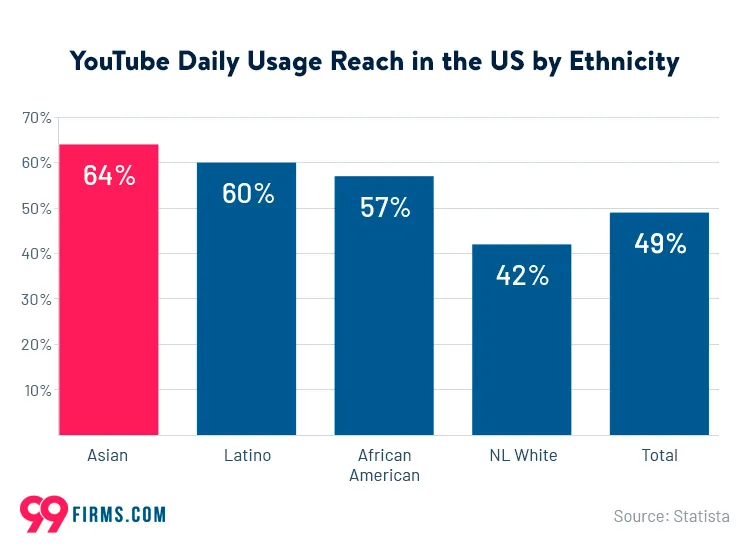
or income group:
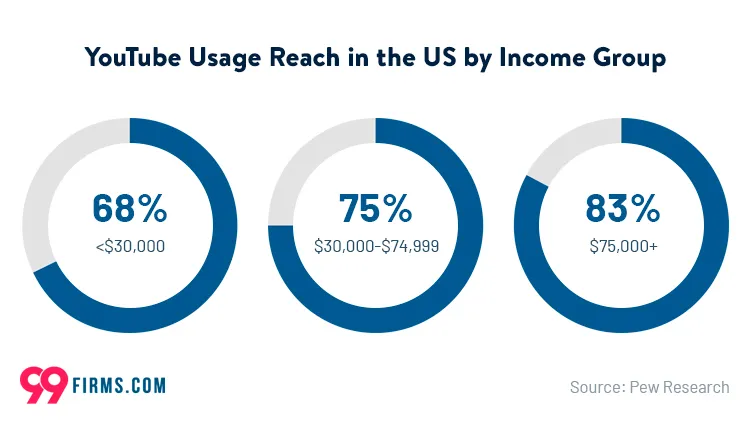
The problem we often see is this, though:
Many businesses use YouTube as a top-of-funnel channel to attract search-driven interest, nurture brand awareness, and funnel viewers into email lists or product pages.
But to improve ROI rather than other vanity metrics, you must optimize for visibility, relevance, and conversion.
First, make the shift: you should increasingly treat YouTube like a search property (akin to website content) rather than “just social media.”
As video SEO matures, you must move from casual content (e.g. random vlogs) to strategic business content aligned with target keywords, user intent, and funnel goals.
This is where optimization matters.
Without YouTube SEO, even excellent video content can get lost in the sea of uploads. After all, over 500 hours of video are uploaded every minute on YouTube.
But the audience you can have access to is massive. The latest stats show that 2.70 billion people use YouTube.
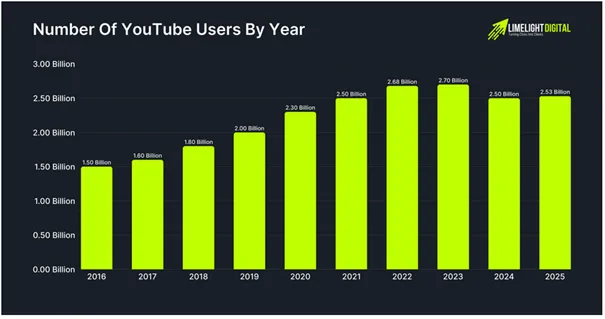
Optimized videos:
- Rise in search engine rankings
- Appear in more search engine results
- Drive organic traffic from both YouTube and Google
- Convert better because viewers are primed for relevance
In 2025, the stakes are even higher. Algorithm changes and competition magnify the rewards and risks.
Optimizing early is now a differentiator.
Here’s an example of how optimization works:
One of our clients, Hurom, is a global juicer brand from South Korea. The company is known for pioneering slow-squeeze juicing technology.
After we increased their website’s organic visibility by 88%, Hurom asked us to increase their YouTube presence as well.
But Hurom wanted more than views. They wanted authority.
Our Bluethings experts built a YouTube SEO engine that turns their episodes into discoverable, search-optimized content. Our goal is to make Hurom Juicing Academy the go-to education hub for juicing and healthy living.
We started before filming. Our SEO team researched trending keywords, audience intent, and gaps in the juicing niche. Each episode outline was built around search demand.
Each 45-minute episode became:
- 4 YouTube edits (2–8 minutes) for organic reach
- 6 short paid cuts (under 60 seconds) for ads and social
Videos went live with optimized titles, tags, and descriptions. Thumbnails were A/B tested monthly to improve clicks and retention.
Every episode also drove one SEO blog article on the Hurom Juicing Academy site, keyword-aligned, educational, and linked to YouTube.
Performance data shaped every update. Titles, visuals, and keywords evolved with audience behavior.
The end result is that Hurom now has a content system that grows smarter and ranks higher over time.
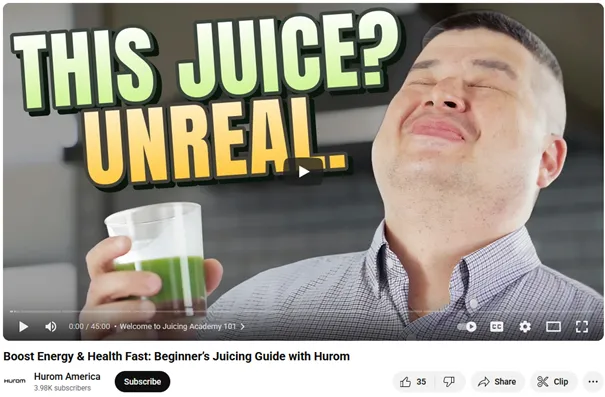
How YouTube SEO Changes Are Impacting Businesses in 2025
The way YouTube ranks and recommends content has changed again. Traditional SEO practices are still important, but you should also understand intent, engagement, and satisfaction.
If you adapt, you will gain more views and turn those views into measurable business results.
If you don’t, your competitors will outperform you.
So, let’s see:
How YouTube’s Algorithm Works: Going Beyond Views
YouTube’s algorithm weighs watch time, audience retention, and engagement signals (likes, comments, shares, CTR) more heavily than raw view counts.
That’s important because 70% of what people watch is driven by the algorithm.
Pro tip: You should optimize your metrics as a whole, not in isolation.
For example, a high CTR (click-through rate) means more impressions, which is an important indicator for YouTube. But if retention falters early, the platform will deprioritize your video.
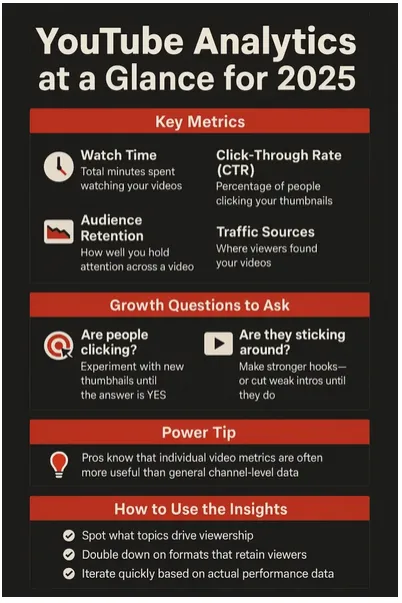
So a video with fewer views but 75% average retention may outrank one with more views but 30% retention.
YouTube also monitors negative feedback like “Not Interested” clicks and “session continuation” metrics, if the viewer stays on YouTube.
Basically, ranking now depends on user satisfaction and what viewers do after watching, not just total views.
That’s why, from our experience at Bluethings, good strategy focuses on:
- Preview
- Hook
- Pacing
- How satisfying the content feels
The Critical Role of Search Intent and Audience Retention for YouTube SEO
To optimize the metrics above, your videos need to match what people are actually looking for.
Someone typing “how to edit video” wants a tutorial. Someone searching “best video editing software review” expects a comparison.
Miss the mark, and viewers drop off fast, which can hurt your ranking.
Keep your content structured with a clear flow, recaps, and teasers to hold attention. When viewers stay engaged, your videos rank better and are more likely to drive conversions.
Pro tip: Not sure where to start? Check out the top YouTube SEO services who can make things clearer for you.
Traditional SEO Principles Are Still Crucial for YouTube Success
The YouTube algorithm is changing, but the SEO basics still matter.
Keyword research, titles, descriptions, tags, and metadata all drive visibility. You can’t skip the fundamentals just because it’s video.
The trick is balancing them with a user-centered strategy.
TL;DR: make high-quality content while using keywords and metadata that match what your audience is searching for.
Connect YouTube Performance Directly to Brand ROI
Views alone don’t pay the bills. What matters is conversions, leads, and SEO ROI.
Use YouTube Studio data, UTM-tagged links, and downstream analytics to tie YouTube traffic to business metrics. That way, your YouTube SEO efforts directly reflect in channel growth, pipeline, and profit.
Our 10 In-House Tips: YouTube SEO Best Practices to Scale Your ROI
We‘ve spent years testing what truly moves the needle for YouTube growth and revenue.
Below, we’ll share proven frameworks that our team uses in real campaigns to drive watch time, conversions, and ROI.
Here is how you can apply the same strategies step by step.
1. Master Intent-Driven Keyword Research for High-Value Viewers
Don’t chase broad volume. A better idea is to focus on long-tail keywords and user intent that map to your funnel.
Use keyword research tools to uncover relevant phrases. YouTube SEO tools we recommend include:
- Google Keyword Planner
- Keyword Magic Tool (from SEMrush)
- TubeBuddy
- VidIQ
For instance, instead of the broader and harder to rank “video editing,” you can target “video editing for marketing agencies 2025” or “YouTube SEO checklist steps.” These longer-tail keywords typically have less competition, so you can easily rank for them.
Side note: When we run internal audits, we often find that 40 to 50% of incremental views come from untargeted long-tail phrases not in the title or tags but appearing in transcripts. That means your keyword targeting must include the voice of your audience and not just idealized search terms.
That way, you’re responding to very specific customer questions, which means you’re increasing valuable metrics like CTR, time on page, or engagement.
Basically, your audience will find exactly what they’re looking for and will stick around longer.
Pro tip: Cross-reference these ideas with Google Trends and YouTube’s own suggestions. Check every keyword on YouTube before you use it. Make sure the results match the content you want to create, whether it’s a tutorial, review, or tips video.
2. Craft Click-Magnet Titles & Descriptions That Drive Viewer Action & CTR
Start your video title with your main keyword and add a value or curiosity hook. Keep it short, around 60 characters, so it doesn’t get cut off in search results. For example: “YouTube SEO 2025: Rank Faster, Earn More”
Your description is the next SEO opportunity.
Lead with the keyword and a strong opening line. Follow with 2–3 paragraphs including internal links to related videos or your website, a transcript snippet, and a clear call to action. The first 125 characters are prime real estate, so make them count.
Add relevant tags, using broad, phrase, and exact matches, but avoid overstuffing for the algorithm.

3. Design Irresistible Thumbnails That Convert Browsers into Loyal Viewers
A strong video thumbnail is the tipping point between a click or scroll in a lot of cases. In fact, thumbnails can affect CTR by 2x or more.
So, use high contrast, bold text overlay, expressive faces, and bright colors. Avoid clutter.
Run A/B tests (via TubeBuddy experiments or internal splits) to see which visuals drive better CTR. Use the CTR benchmark of 5 to 7% as guidance.
Captain Obvious tip: If you’re below 3%, your thumbnails/ titles likely need optimization.
Also include alt text (on the underlying image file or via schema) when embedding on a website, as this will improve image optimization.
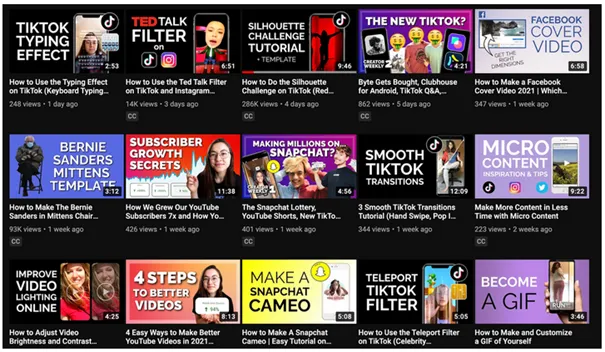
4. Leverage Transcripts & Captions for Enhanced Accessibility & Global Reach
These days, having a video transcript and captions is non-negotiable. And it’s not just for podcast episodes anymore; YouTube demands it, too.
Think about it.
Transcripts improve accessibility and help your videos reach a global audience. They also give search engines more content to index. In fact, some studies show videos with transcripts rank for about 95% of their target keywords.
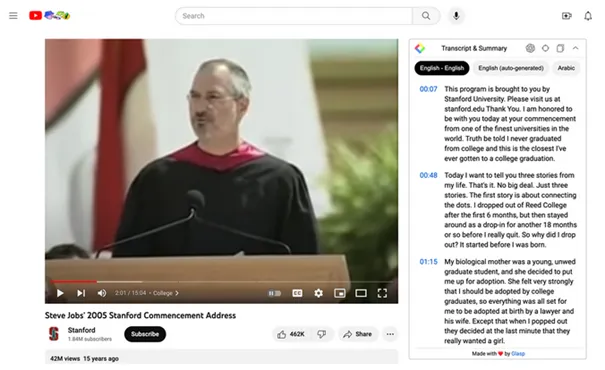
Transcriptions are easy to do.
Upload captions through YouTube Studio and include the full transcript in your description or on the video page if embedded.
Pro tip: Don’t just paste the script. Edit it for readability, add punctuation, headings, and internal links where possible.
5. Strategically Integrate Timestamps & Chapters for Superior User Experience & Search Visibility
Break your longer videos into clear chapters so viewers can jump to what they need.
Add timestamps like this: 0:00 Intro | 1:35 Step 1 | 4:20 Step 2 | 6:50 Tips | 9:15 Wrap-up.
YouTube picks them up automatically if you format them right.
Chapters make your video easier to navigate and keep viewers engaged longer. They also help with SEO because search engines can understand your content structure better. Plus, people are more likely to stick around when they can skip to the sections they care about.
Basically, you get:
- Easier navigation (better user experience)
- Users can jump to relevant parts (boost retention)
- Google may show those chapters in search engine results as mini-snippets
Make sure each chapter name includes relevant keywords or phrases to widen your search engine rankings potential, like so:
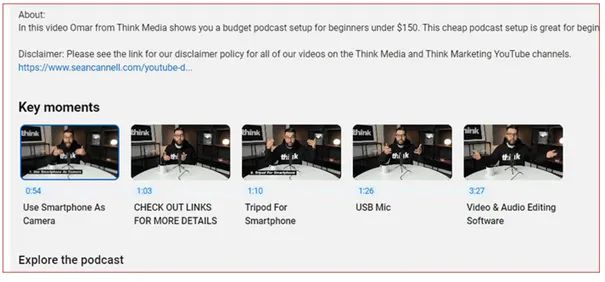
Watch this video to find out how to add timestamps quickly and easily:
6. Implement Cards & End Screens to Guide Viewers to Your Next Conversion Point
Cards and end screens are powerful tools to keep viewers in your ecosystem:
- Use cards to highlight related videos, playlists, or external CTAs like a lead magnet.
- Use end screens in the last 5 to 20 seconds to promote the next video or drive traffic to your website or offer.
Of course, place them (especially the cards) at natural pause points, not too early in the video. The goal is to keep the session time on your channel high.
Test different placements and calls to action to see what drives the most engagement and conversions.
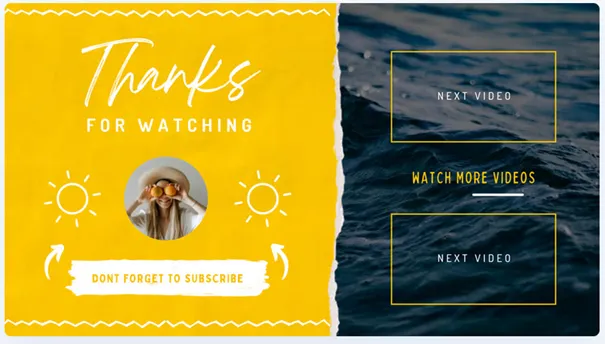
7. Boost Engagement Signals: Watch Time, Audience Retention & Interaction to Sway YouTube’s Algorithm
As we explained above, engagement is one the currencies YouTube values most.
A video can show up in search results initially. But long-term reach depends on suggestions and algorithm-driven recommendations.
Watch time, audience retention, and interactions all determine how far your content spreads.
Use these tactics to keep viewers engaged:
- Start with a strong hook in the first 10 to 15 seconds
- Preview what’s coming and tease the next section
- Break content into mini-sections so viewers feel progress
- Ask rhetorical questions, run polls, or prompt viewers to comment
- Encourage shares or retweets during high-emotion moments
Pro tip: Check YouTube Studio analytics to spot where viewers drop off. You can then adjust your pacing or segment structure accordingly.
8. Amplify Your YouTube Content with Strategic Cross-Promotion & Internal Linking
Don’t put all your eggs in the YouTube basket.
Share your videos on social media platforms like LinkedIn, X (Twitter), and Instagram to reach different audiences. Embed them in blog posts, newsletters, and across your website to give people more ways to find your content.
Every embed and backlink:
- Drives organic traffic
- Can improve your Domain Authority
- May boost your website’s ranking
- Makes your channel more likely to be picked up by LLMs
Side note: Interested in getting ahead in AI Overviews or ChatGPT? Here are the 10 best LLM optimization tools to help you do that.
The more places your video lives, the more opportunities you create for people to discover it and stay engaged.
And inside YouTube, remember to make the most of internal linking with playlists, cards, and end screens. As we explained above, you want to guide viewers to related content to keep them watching longer and increase session time.
Besides, these links have an important SEO purpose because they show YouTube how your content fits together. That makes it easier for the algorithm to recommend your videos to the right viewers.
9. Use YouTube Analytics for Data-Driven Optimization & Scalable Growth
Your YouTube Studio is your command center. Track the metrics that matter most: CTR, traffic sources, audience retention, watch time, demographics, and dropoff points.
Besides, this tool shows you how your audience finds your clips, like so:
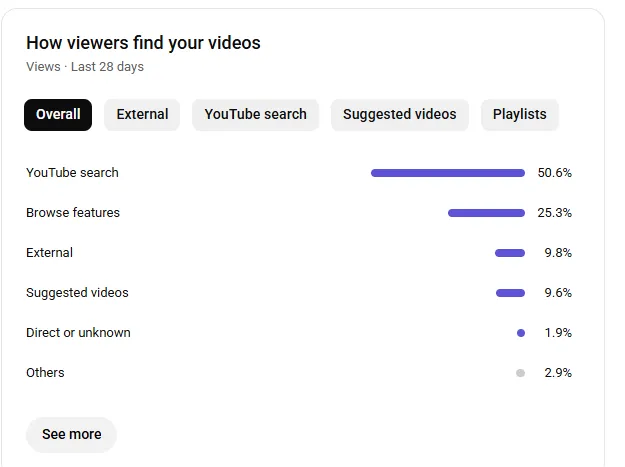
If you’re not happy with what you see, run experiments with new thumbnails, intros, or formats and track the improvements. TubeBuddy offers basic A/B testing tools for thumbnails, titles, tags, for example. And VidIQ tracks analytics and gives you more optimization insights.
Of course, you’ll need to focus on the right issue to fix your metrics:
- Low CTR typically demands more focus on thumbnails and titles.
- If retention drops fast, you’ll need to adjust pacing or sequence.
Next, use what you learn to scale. Double down on content formats, topics, and styles that consistently perform.
10. Future-Proof Your Strategy: AI as Your YouTube SEO Co-Pilot for 2025
AI is great for scaling video SEO.
At Bluethings, we use it for:
- Topic ideation via keyword research tools powered by generative models
- Generating video description templates or title alternatives
- Auto-generating transcripts and time-synced chapters
- Predicting CTR or retention risk spots
- Performing thumbnail idea generation
For example, let’s say you need to get high-performing video ideas.
Start by looking at your top 10 past video titles and the keywords that worked best. Feed those into GPT-5 to generate five new titles and thumbnail ideas. Then A/B test them against your current versions to see what really drives clicks and watch time.
This keeps your content fresh, relevant, and constantly improving.
Remember: AI is your co-pilot, not your replacement. Human creativity, domain expertise, and editorial judgment still drive results.
Bonus Tip: Integrate Your YouTube SEO Efforts for Holistic Digital Marketing ROI
YouTube can’t operate in isolation.
Tie your video SEO to your website, search strategy, and content ecosystem so every channel strengthens the others.
This approach creates a unified system that drives measurable ROI across all digital touchpoints.
YouTube & Google Search SEO: Embedded Videos & Schema Markup
Embedding YouTube videos into your web property gives SEO lift to both sides. A page with an embedded video can get 41% higher organic traffic than one without.
Pro tip: Use structured data (JSON-LD VideoObject schema) so search engines can interpret your video. That way, it can become eligible for rich snippets, video carousels, and better search engine rankings.
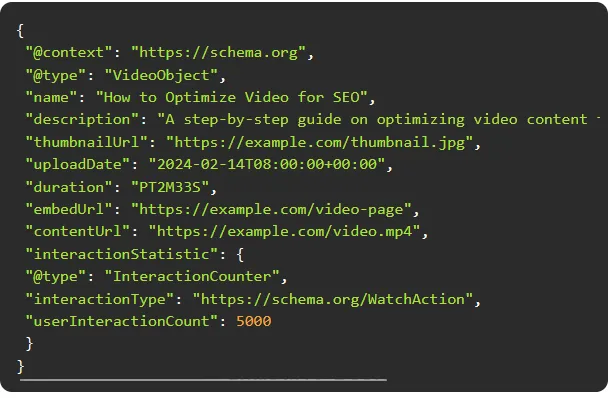
When embedding, place the video high on the page (above the fold) to signal importance.
Use the same video title, video description, thumbnail URL, duration, and transcript in your schema markup for consistency.
Here’s a quick tutorial on how to make it happen:
But don’t stop at that.
Keep classic on-page SEO sharp: optimize headings, internal links, and alt text for images or thumbnails. Make sure page speed is fast using Google PageSpeed Insights, and check mobile responsiveness and HTTPS security.
Strong website SEO management supports your videos and helps rankings across the board.
Cross-Channel Content Strategy: Repurpose YouTube Video for Social Media & Beyond
Turn your long-form videos into short clips, reels, quote cards, audiograms, or blog embeds.
Share them across social media, email newsletters, LinkedIn posts, and as part of your SEO-driven video marketing campaigns.
Each clip acts as a doorway, bringing viewers back to the full video or your brand site. One video can create multiple entry points, extending reach and multiplying ROI across every channel.
Measure YouTube SEO Beyond Views: Leads, Conversions, Brand Lift
Connect your metrics to real business outcomes with UTM tags and tracking in Google Analytics or your CRM. Track how many leads, signups, or purchases come from YouTube referrals. Use tools like Google Search Central and Search Console to measure video-driven organic traffic.
For brand impact, run surveys or YouTube Ads brand lift studies to estimate how much awareness and recall your organic videos are generating. This shows the full value of your video strategy beyond clicks and views.
Competitive Advantage of a Proactive, Data-Driven YouTube Strategy
A disciplined, data-driven YouTube SEO strategy gives you the edge.
It drives channel growth, stronger search rankings, and sustainable ROI. Brands that move fast, test relentlessly, and focus on user intent outperform those chasing views alone. Views alone won’t cut it.
Focus on intent and you’ll be able to win over the algorithm and win the game.
Your Blueprint for YouTube SEO Success in 2025
YouTube SEO in 2025 is about more than uploads. It’s where creative video strategy meets rigorous SEO.
Start with intent-driven keyword research. Craft titles that grab clicks and thumbnails that stand out. Use transcripts, schema markup, and website integration to multiply impact. Layer in cross-promotion, internal linking, and YouTube Studio analytics to see what works. AI tools help scale the process without losing precision. Connect views to conversions and audience retention to brand lift. Optimize across platforms consistently.
When done right, YouTube stops being just a discovery channel and becomes a growth engine.
Ready to grow? Get in touch today and maximize your ROI with YouTube SEO.
FAQ
Why is YouTube SEO important for my brand?
YouTube SEO drives visibility, engagement, and growth. Optimized videos reach the right audience, improve watch time, and feed into broader content strategies. When paired with your website and marketing channels, it turns YouTube from a discovery platform into a measurable growth engine.
How do I optimize video titles and thumbnails?
Lead with your primary keyword and add a hook that sparks curiosity or highlights value. Keep titles concise so they don’t truncate in search results. Test multiple thumbnail variations to see what drives clicks, using A/B testing tools or internal analytics to find the best-performing combination.
What role do transcripts and chapters play?
Transcripts make videos accessible, boost search visibility, and help search engines index long-tail phrases. Chapters break content into digestible sections, improve retention, and allow viewers to jump to what they need. Together, they enhance engagement and help YouTube understand your video’s structure and topics.
How can AI help my YouTube SEO workflow?
AI speeds up keyword research, generates title and description options, predicts retention risks, and suggests thumbnail ideas. It acts as a co-pilot, giving you scalable insights while human creativity, editorial judgment, and domain expertise guide the final strategy for maximum impact.
How do I measure ROI from YouTube?
Track performance through UTM tags, Google Analytics, or a CRM to see leads, signups, and conversions from YouTube traffic. Monitor watch time, retention, and audience engagement. Combine this with brand lift studies or surveys to quantify awareness and recall, linking video success directly to business outcomes.

.webp)
